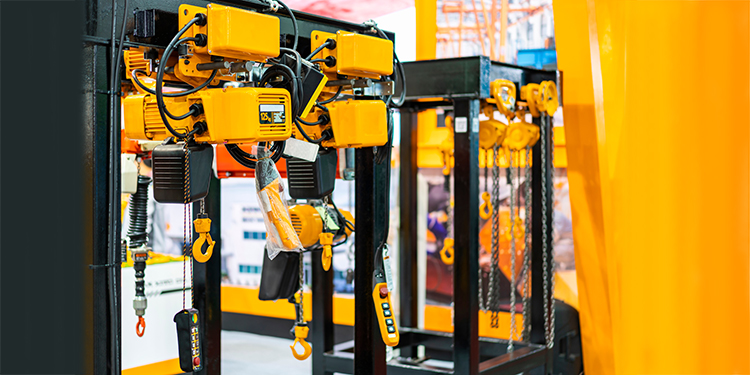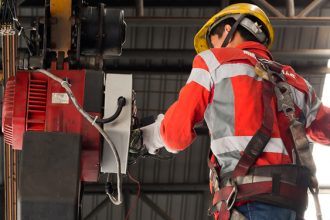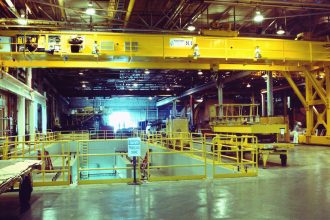The “Dos And Don’ts” Of Monorails

Used as an alternative to lift trucks or fixed conveyor systems, monorails transport heavy, bulky materials through a process or within a facility, then position the loads. They are supplied in two different track styles — patented track and enclosed track — and are outfitted with suspended carriers (trolleys). Moved manually or powered with pneumatic or electric tractor drives controlled by an operator with a wired pendant or wireless remote, monorails enhance worker safety and ergonomics; free up floorspace; boost productivity; and deliver highly efficient movement with precise positioning.
Facility owners considering the integration of a monorail system into their facility (or those with an existing system) have a variety of responsibilities that are critical to the safe operation of this equipment. That’s why the Monorail Manufacturers Association (MMA) publishes multiple specifications and recommended practices for the design, operation and service of monorails. In addition, the members of MMA have also assembled a list of workstation crane equipment “Dos and Don’ts.” Following these recommendations will enhance both the integrity and reliability of the equipment, as well as reduce the risk of injury for workers as they operate the system or work in proximity to it.
Monorail Equipment Dos…
- Do ensure that the monorail system is installed by a qualified installer, according to the manufacturer’s instructions, and exactly to the system layout drawings.
- Do verify that the building or freestanding monorail support structure is strong enough to support a fully loaded system.
- Do confirm during the design phase that adequate clearance has been included to permit the load to move freely and to clear all obstructions.
- Do verify that any splice connections in the rails are supported to ensure the load baring capacity is continuous through the system.
- Do confirm that load travel is in the same direction as shown on controls.
- Do read the owner’s manual. These informational documents — developed by the monorail’s manufacturer — contain specifications, dimensions, operation instructions, inspection criteria, parts lists, and more.
- Do understand that the Occupational Safety and Health Administration (OSHA) requires facility operators to provide their employees with equipment that is both safe and operates property.
- Do inspect the monorail prior to the start of each shift before operation, as well as at frequent and periodic intervals.
- Do report damage, malfunctions, or unusual performance of the monorail to managers immediately.
- Do ensure all employees/operators who will use the monorail have been trained on its proper use and operation by someone who has experience with the equipment.
- Do follow all safety precautions specified by the manufacturer of the monorail when operating the equipment.
- Do operate the monorail properly and safely, ensuring the following prior to and during use:
- Proper sizing of load slings or attachments
- Familiarity with operating controls, procedures and warnings
- Secure attachment of the unit to a suitable support prior to applying the load
- Careful take-up of slack, verifying that the load is balanced and load holding action secure before lifting
- Confirm all personnel are clear of the supported load
- Verify that end stops and/or travel limit switches work properly
- Warn other personnel of an approaching load
- Maintain a firm footing when operating the system
- Avoid swinging the load or hook
- Check brake functions by tensioning the load before lifting
- Do perform regular preventive maintenance, including lubrication, as specified by the monorail manufacturer to ensure long service life.
- Do engage independent service and inspection professionals with experience on the specific monorail if outsourcing preventive maintenance and repairs.
Monorail Equipment Don’ts…
- Do not misplace or throw away the owner’s manual. This document is a critical resource for owners and operators of monorail.
- Do not install the monorail in a location where it will be subjected to interference or contact from other systems, structures, or objects.
- Do not allow untrained operators to use the monorail.
- Do not attempt to operate a monorail that has been tagged out-of-service.
- Do not allow an operator to attach a load without first having proper training.
- Do not attempt to lift a load that exceeds the capacity rating of the monorail.
- Do not use a monorail whose lifting attachment or hoist has a twisted, kinked, damaged or worn wire rope or chain.
- Do not use a system with damaged, bent, or deformed track sections or hangers.
- Do not operate a system that has worn trolleys or end truck wheels.
- Do not operate the monorail unless the load is centered first.
- Do not use limit switches and end stops as a routine method to stop load movement; this will cause premature wear of the components.
- Do not use the monorail for any purpose outside its specified function, including lifting, supporting, or transporting people.
- Do not lift or move loads over people.
- Do not allow an operator’s attention to be diverted during operation of the monorail.
Looking for more information on monorails? Consult the members of the Monorail Manufacturers Association (MMA), who are the industry’s leading suppliers of monorails and workstation cranes. Available to answer any questions, the group also offers a variety of resources — including a product certification program, recommended practices for workstation cranes and patented track systems, and more — via its website at www.MHI.org/MMA.



